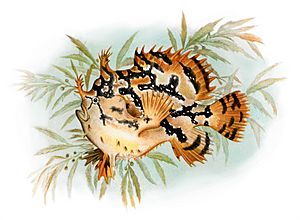Sargassum fish facts for kids
Quick facts for kids Sargassum fish |
|
|---|---|
 |
|
| A well-camouflaged fish | |
| Conservation status | |
| Scientific classification |
The sargassum fish is also known as the anglerfish or frog fish. Its scientific name is Histrio histrio. This special fish is the only one of its kind in its group. It lives among Sargassum seaweed that floats in warm parts of the ocean. The name histrio comes from a Latin word meaning "actor." This is because of how the fish hunts for its food.
Contents
What Does the Sargassum Fish Look Like?
The sargassum fish looks quite unique! It blends in perfectly with the seaweed where it lives. Its body is flat on the sides and can grow up to 20 centimeters (about 8 inches) long.
The fish's body and large mouth can be many different colors. Usually, it has spots and blotches of yellow, green, and brown on a lighter background. Its fins often have dark stripes. This fish can change its color very quickly, from light to dark and back again.
Its body and fins are covered with many parts that look like seaweed. This helps it hide even better! Its skin is smooth, without any sharp spines.
The sargassum fish has three spines on its back fin. The front spine is special. It looks like a thin growth on its upper lip, with a fleshy lump at the end. This lump is called an esca, and the fish uses it like a fishing lure!
You might not see its gills easily. They open as small pores near the base of its side fins. Its belly fin has no spines. The fins on its belly are large, and its side fins have rays and can grip onto things like stalks of seaweed. The outer parts of its tail fin are simple, but the middle parts are forked.
Where Does the Sargassum Fish Live?
The sargassum fish lives all over the world in warm tropical and subtropical seas. It can be found down to about 10 meters (33 feet) deep. You can find it in parts of the Atlantic Ocean and the Indo-Pacific Ocean. These are places where floating seaweed gathers.
In the western Atlantic, it lives from the Gulf of Maine all the way south to Uruguay. It has even been seen as far north as Norway. However, that sighting was probably because it was carried there by ocean currents.
How Does the Sargassum Fish Live?
The sargassum fish is a very hungry hunter! It waits hidden and then ambushes its prey. It can even eat other sargassum fish. Scientists once found 16 young sargassum fish in the stomach of one adult!
This fish hides among the tangled seaweed. Its amazing camouflage helps it stay unseen. It can climb through and hold onto seaweed stalks using its special side fins.
It dangles its esca, that fleshy lump on its head, like a fishing lure. This attracts small fish, shrimp, and other tiny sea creatures. When prey gets close, the sargassum fish can dart forward very quickly. It shoots water out of its gill openings to help it move fast.
It can open its mouth incredibly wide, much bigger than its normal size, in a tiny fraction of a second. It sucks in its prey, even if the prey is bigger than the fish itself!
Sargassum Fish Reproduction and Life Cycle
Sargassum fish have male and female fish. When it's time to lay eggs, the male fish follows the female closely.
When the female is ready, she quickly swims up to the surface of the water. There, she lays a big mass of eggs that are stuck together with a jelly-like slime. This egg raft sticks to the seaweed, and the male fertilizes the eggs.
When the baby fish hatch, each one is surrounded by a special skin-like cover. They have a large, round head, fully formed fins, and eyes. As the baby fish grow, this cover joins with their skin.
Bigger fish and sea birds sometimes eat sargassum fish. To escape dangers underwater, this fish can actually jump out of the water onto mats of seaweed! It can even survive for some time out of the water.
See also
 In Spanish: Pez de los Sargazos para niños
In Spanish: Pez de los Sargazos para niños



